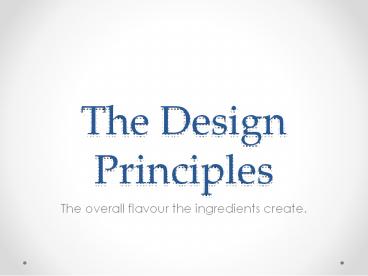The Design Principles - PowerPoint PPT Presentation
1 / 23
Title:
The Design Principles
Description:
... Asymmetrical and Radial forms. ... Balance Symmetrical Balance A- Symetrical Balance Radial Balance Contrast Contrast can come in a variety of different ... – PowerPoint PPT presentation
Number of Views:121
Avg rating:3.0/5.0
Title: The Design Principles
1
The Design Principles
- The overall flavour the ingredients create.
2
The Design Principles
- Design Principles refer to the use and creative
positioning of the Design Elements. They tie up
all of the elements and allow for the page to
take on a certain style.
3
The Design Principles
- Design Principles refer to the use and creative
positioning of the Design Elements. They tie up
all of the elements and allow for the page to
take on a certain style. - Alignment
- Balance
- Contrast
- Dominance/Emphasis
- Flow
- Unity
- Whitespace
4
Use of the Design Principles
- In your DTP work.
- The layouts should have been evaluated based
against the Design Principles. - In the exam.
- Knowledge of the Design Principles and how the
effective use of Design Elements can create them.
5
Alignment
- When all the features on a page are lined up in a
specific way they allow the readers eye to move
across the page easily.
6
Alignment
- When all the features on a page are lined up in a
specific way they allow the readers eye to move
across the page easily. This is due to the page
having a neat and structured look aligning can
achieve.
7
Alignment
- When all the features on a page are lined up in a
specific way they allow the readers eye to move
across the page easily. This is due to the page
having a neat and structured look aligning can
achieve. - 4 ways of ALIGNING a page.
8
Alignment
- 4 ways of ALIGNING a page.
9
Alignment
- 4 ways of ALIGNING a page.
Right Aligned
Left Aligned
Centre Aligned
Justified
10
Balance
- Balance can be found in Symmetrical, Asymmetrical
and Radial forms. However they all give off
different feelings and moods. - What type of balance would you expect to use in
the following designs - Formal and Corporate
- Fun and Relaxed
11
Balance
- Balance can be found in Symmetrical, Asymmetrical
and Radial forms. However they all give off
different feelings and moods. - To discuss Balance you have to discuss the
position and size of the Design Elements on the
page.
12
Balance
- Symmetrical Balance
- A- Symetrical Balance
- Radial Balance
13
Contrast
- Contrast can come in a variety of different ways
through colour, shape and fonts. Contrast can be
eye-catching however when it is over used it can
look messy and detract from the message.
14
Contrast
15
Contrast
Font Architecture is a structured sans serif
font which is modern however the fun font used
underneath contrasts with this and allows the
reader to know its going to get interesting.
Shape The modern curves of the car contrast
against the straight and linear columns and photo
graphs.
Colour The lack of colours is striking. Only
Black and White is used to create a dramatic look.
16
Dominance and Emphasis
- The size, colour and tones all contribute to the
amount of focus a feature can create in a page.
Generally this is found more in Headings and
Subheadings but as you can see her Images can
control the users focus.
17
Flow
- The layout of graphical items should allow a
readers eye to glide over the page and take in
each piece of information with the correct amount
of attention.
The amount of Dominance has to be correct to
allow this to work.
18
Unity
- The spacing of items, the colour, the shape of
items allows us to understand if items are
connected. - Items close together/overlapping tend to be
related however something that is on its own
helps create independence.
19
Unity
- The spacing of items, the colour, the shape of
items allows us to understand if items are
connected. - Items close together/overlapping tend to be
related - An item that is on its own helps create
independence.
20
Unity
- The spacing of items, the colour, the shape of
items allows us to understand if items are
connected. - Items close together/overlapping tend to be
related - An item that is on its own helps create
independence.
21
Whitespace
- An empty area on the page it should have no text
or imagery, allowing the eye to rest.
22
Exam Question
- On the following page explain how the following
Design Principles have been used? - Unity
- Balance
- Contrast
- Alignment
23
Exam Question































